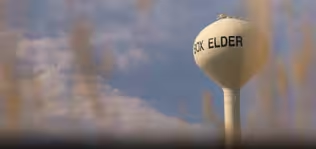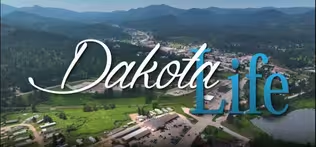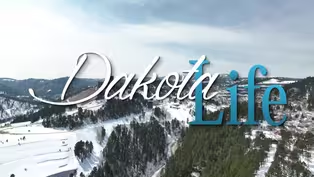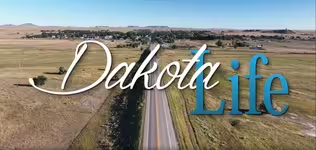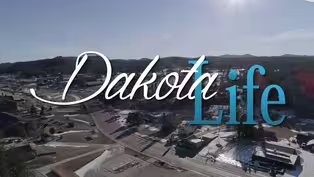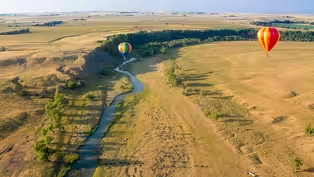Dakota Life
Greetings from Belle Fourche
Season 25 Episode 8 | 28m 42sVideo has Closed Captions
Dakota Life travels to Belle Fourche
We tour the Center of the Nation Wool warehouse that handles one-quarter of all the wool in the united states. We experience The Belle Fourche Cowboy Band, a point of pride in the community since 1931. We visit the Belle Fourche reservoir and dam. When it was finished in 1907, the dam was the largest earthen dam in the world. And a local ceramic artist shows us her creative process.
Problems playing video? | Closed Captioning Feedback
Problems playing video? | Closed Captioning Feedback
Dakota Life is a local public television program presented by SDPB
Support Dakota Life with a gift to the Friends of Public Broadcasting
Dakota Life
Greetings from Belle Fourche
Season 25 Episode 8 | 28m 42sVideo has Closed Captions
We tour the Center of the Nation Wool warehouse that handles one-quarter of all the wool in the united states. We experience The Belle Fourche Cowboy Band, a point of pride in the community since 1931. We visit the Belle Fourche reservoir and dam. When it was finished in 1907, the dam was the largest earthen dam in the world. And a local ceramic artist shows us her creative process.
Problems playing video? | Closed Captioning Feedback
How to Watch Dakota Life
Dakota Life is available to stream on pbs.org and the free PBS App, available on iPhone, Apple TV, Android TV, Android smartphones, Amazon Fire TV, Amazon Fire Tablet, Roku, Samsung Smart TV, and Vizio.
Providing Support for PBS.org
Learn Moreabout PBS online sponsorshipMore from This Collection
Dakota Life stories from towns in western South Dakota
Video has Closed Captions
The community of Box Elder is one of the fastest-growing cities in South Dakota. (28m 52s)
Video has Closed Captions
Greetings from the ranching community of Union Center. (27m 53s)
Video has Closed Captions
Visit an artist coop, the state railroad museum, gardening enthusiasts, and an annual film (25m 49s)
Video has Closed Captions
Dakota Life visits Custer and the surrounding area. (24m 56s)
Dakota Life: Postcard from Hot Springs
Video has Closed Captions
Dakota Life: Postcard from Hot Springs (29m 49s)
Providing Support for PBS.org
Learn Moreabout PBS online sponsorship(upbeat music) - [Announcer] This is a production of South Dakota Public Broadcasting.
(bright music) - Legend has it that when French speaking frontiersmen first laid eyes on the confluence of the Belle Fourche and the Redwater Rivers, they called it Belle Fourche, or Beautiful Fork.
Well, from that time through today, the name stuck, not only for Belle Fourche the river, but also the town that grew up from the high prairie surrounding that beautiful fork.
Belle Fourche, the town, was born largely through the efforts of two men, Seth Bullock, the legendary Deadwood sheriff, businessman, and US Marshall, and his close friend, Theodore Roosevelt, the president of the United States.
You see, ranchers in this area wanted a railroad depot so they could get their cattle to market.
Bullock figured his ranch was as good place as any to build it.
Bullock offered Fremont, Elkhorn, and Missouri River Rail Line free right of way through his ranch.
He even threw in a depot and a saloon.
By late 1890, loads of cattle started shipping east.
By 1895, carloads of cattle were shuttled east at the rate of 1,000 head a day.
By then, the population had exploded to over 2,500.
Seth Bullock's town had acquired a rowdy cowboy reputation, with many saloons and houses of ill repute on Saloon Street.
Today, that's known as Fifth Street, but also in 1895, the business district was destroyed by a raging fire.
Though Belle Fourche began to settle down, the cowboy culture still runs deep here.
The all-volunteer run Black Hills Roundup, which celebrated its 103rd year in 2022, brings in around 30,000 visitors annually.
From the sandstone storefronts on State Street to the bronze sculptures of rodeo legends by local artist Tony Chytka, Belle Fourcheu is still unmistakably a cow town and a sheep town, steeped in Western heritage, but looking forward from beneath its brim.
Welcome to "Dakota Life."
Greetings from Belle Fourche.
(upbeat music) - [Announcer] Support for this program comes from Belle Fourche Economic Development and Chamber of Commerce, developing and supporting business, engaging the community, and serving the ag, ranch, and rodeo industry, homegrown and growing, and by Pioneer Bank and Trust, providing personal agriculture and commercial banking services to Western South Dakota for more than 100 years.
Pioneer Bank and Trust is local, member FDIC.
- The Black Hills Roundup began in 1918.
It began as a Red Cross blood drive and a fundraiser in response to the heavy fighting and the influenza that raged across World War I's western front.
Some 15,000 people showed up from around the region to take in the rodeo's debut.
There weren't any grandstands or shoots in those days.
It was an open field, and spectators sat and watched while riders mounted broncs, held at the ready by other riders.
Livestock were auctioned to aid the war effort, and a woman named Elsestar Rose raised over $5,000 as bidders bought and resold her lamb many times over.
The following year, there was a higher level of competition.
Charles Wilson of Camp Crook brought his legendary bucking horse Temporary.
Champion rider Sam Brownell gave him a good run, but was disqualified for making an illegal hand change.
In 1920, Temporary was back, and Enos Yakima Canutt was the first to get the best of it.
He repeated that feat in the 1921 Roundup.
In the Roundup's early days, many events were open to men and women.
Mildred Douglas of Connecticut was a champion bronc rider, a trick rider, and the first known female steer wrestler.
Douglas is a National Cowgirl Hall of Famer, and competed at the Roundup through the 1920s.
Many rodeo greats were born and raised right here in Belle Fourche, the brothers Mark and Marvin Garrett, both Pro Rodeo Hall of Famers and multiple national finals rodeo champions.
The Garrett brothers are immortalized in bronze with sculptures cast by Tony Chytka on State Street downtown.
Another Roundup tradition is the Belle Fourche Cowboy Band.
It was formed in 1931, and still comes out to rouse the crowd at the Roundup, and at the parade and a few other regional hoedowns too.
Coming up, we'll visit the Center of the Nation Wool Warehouse.
We'll see why this business is so important to the garment industry.
We'll see why water is important around here, and just how it's managed, and then we'll visit a talented and creative ceramicist.
But first, we'll take you to Belle Fourche's Annual 4th of July parade.
The Belle Fourche Cowboy Band is the star of the show that brings thousands of parade watchers from far and wide.
SDPB's Brian Gevick caught up with the Cowboy Band to find out what keeps the pep in their step.
- [Brian] There might be another town in America that loves the 4th of July as much as Belle Fourche does, but it's not likely.
People show up early for a good spot on the parade route.
(marching band playing upbeat music) A high school band leads a long column of rodeo queens, (car motor humming) antique cars, horses and wagons, and politicians.
This year's Miss South Dakota is here, and it's warm enough by late morning for a water balloon fight.
A lemonade stand suggests that free enterprise is alive and well here in Belle Fourche, and in the middle of it all comes the Belle Fourche Cowboy Band.
(Cowboy Band playing lively music) This is not the band's first rodeo.
It was founded in 1931.
They marched in their cowboy hats and chaps through the Depression, World War II, and well into the post-war years.
People lost interest for a few years in the 1960s and '70s, but the outfit reorganized in the 1980s.
Things being what they are, the band gave up marching in the 4th of July parade years ago.
- When they made the parade route far too long for marching, and we do have a larger range of ages in this group, so that makes marching a two mile parade kind of out of the question on a hot day.
- [Brian] Kevin Rathert has been with the band for 22 years.
- It's fun, I have to play, and there are some really wonderful people in this band.
There's a lot of tradition, a lot of history, and that keeps bringing me back.
- [Brian] There are some serious musicians in the Cowboy Band.
(orchestra playing mellow music) They do rehearse, they do play concerts, and small groups of band members gather to play in various places year round.
- [Parade Goer] Here they go, there's your granddad.
(drum playing a march) - [Brian] 4th of July always brings a lot of Cowboy Band alumni back to Belle Fourche.
Molly O'Connell came all the way from Northern New Hampshire.
- I play whatever they tell me to play.
I started out as a flute, and then switched to alto, and then tenor, and finally bari sax.
Actually, I think the first time I played with the band, I played in the cymbals, and then the bass drum, but that was a while ago.
So I kind of show up and they tell me what to do.
I get to see so many people here that I wouldn't normally get to see.
They're people that I grew up with that I think are awesome.
A lot of the older folks, you know, watch them come and go, and they're people that I aspire to be, so and that's what kept me with it.
And now it's just like I blow in here on a trip and give everybody a hug, play a little music, and then blow outta here again.
- [Brian] Gary Fladmoe was born and raised here.
He moved away after college, but moved back after he retired.
- I started playing when I was nine, so I've been playing the trumpet for 70 years, and made it into the high school band when I was in the sixth grade, and started in the Cowboy Band then.
- [Brian] Fladmoe really likes to see young people in the band.
- Our new director, Dave Burbrick from Black Hills State has encouraged some of his college students and graduates to play, and they seem to enjoy it.
And the new high school band director, he's in his third year now, has got some of his students coming.
So it's harder now, because kids work in ways that they didn't back when I was a kid.
(drums playing a march) - [Brian] If they don't know it already, young people who join the band will find out that what makes the Belle Fourche Cowboy Band so special isn't the music.
It isn't the marching.
It's about the friendships, it's about the tradition, and if they should ever leave, it's about the best way that Belle Fourche can say welcome home.
- The oldest building in Belle Fourche is a split log cabin.
It was built near the Redwater River by Frontiersman Buckskin Johnny Spalding in 1876.
The cabin has been moved and restored at the Tri-State Museum.
That's at the Center of the Nation Monument site.
Now, that recognition is being the geographical center of our nation.
Well, that's actually on a farm about 20 miles north, but since Belle Fourche was the closest town, citizens felt a monument was the least they could do.
The only two buildings downtown to survive that fire in 1895 were the stone Scottly Building and Ferrell's Drugstore building across the street.
In the early days of Belle Fourche, cowboy bars ran up and down the block and were open 24 hours a day.
The famous Deadwood Madam Dora DuFran ran one of several brothels on Saloon Street.
She also had another one on a boat docked in the river.
In 1897, robbers hit the old Butte County Bank.
They claimed that they were part of the Wild Bunch, made famous by "Butch Cassidy and the Sundance Kid."
What is confirmed, though, is they got away with less than $100.
The robbery was a comedy of errors.
Gang member Tom O'Day was in charge of the gang's horses, but he'd had too much to drink.
He lost his own horse, and was eventually arrested in an outhouse behind the bank.
Most of the others, though, did get away.
O'Day found a good lawyer, and he was acquitted.
Belle Fourche still has a uniquely Western way of life here on the edge of the Black Hills.
It's a community of people making a living and finding happiness in all kinds of ways.
For a former kindergarten teacher turned ceramics artist, Linda Hefty uses a steady hand to turn clay into objects that are both beautiful and useful.
(clay swooshing) - Pottery is kind of a slow craft.
Nothing gets done very fast.
If you try to go too fast, then you're in trouble in a short order.
(chuckles) My name is Linda Hefty, and I live in beautiful Belle Fourche, South Dakota.
Step into my studio.
What I'm going to make today is a nice sized mug.
It takes two pounds of clay to make the size that I'm thinking of.
I've always loved pottery.
I actually taught kindergarten for many years, and I think anytime you're using your hands to create a painting, or pottery, or weaving, or sculpting, you're creating something, and it's yours.
It's unique to you.
It could be a one of a kind, but it's your thing.
It's your flavor of creativity, and that's so true in kindergarten where kids create a ton of things.
I've never been real good at sitting still.
I can work as late as I want or get up and come down into my studio and work as early as I want in the morning, and it's just a wonderful way of creating things that I picture in my head or that I think about.
I do a lot of that thinking when I go to bed at night.
Sometimes it keeps me awake about what the next thing is I want to make, or what colors of glaze I wanna use on something that I have made.
But it's just an activity that, for me, is very fulfilling.
Now, my next step is I wanna start bringing this very thick wall up, and making it thinner, like the wall of the mug needs to be.
So I like to keep moisture on the inside and the outside so my hands slide easily, and I begin to squeeze my two fingers together, and start to bring that wall up higher.
You get better at it as you do it, like any other skill, practice, practice.
Basically, I think about what I wanna make before I even cut clay off the brick, because I need to know how many pounds it that object is going to be, so how much clay do I need to take off the brick?
And then I work it with my hands.
The purpose of working it is so that if there are any little air bubbles, I'll work those out.
It also activates the molecules in the clay itself so it becomes pliable and very nice to work with.
And once I've wedged it or worked it, kneaded it, like you'd knead bread dough, then I put it on my bat, which is nothing more than a platform, and I work it into a cone, and then I press it back down.
And again, all of that movement is activating molecules and making that clay more receptive to my forming it into something.
The things that I make are basically for functioning.
What can I use it for?
So I make mugs, and bowls, and honey jars, and garlic jars, and berry bowls, and things that I know have a use.
That's kind of where I'm at.
I always like to think, "Okay, what can I use this for?"
And now this mug is ready to receive a handle and any kind of a logo that I might wanna attach to it.
(objects rattling) I like my handles just a bit wider at the top than at the bottom, and I simply curl the handle around, and I like to attach it about right here.
Now, while that handle is getting a little air and drying a bit in front of my fan, I go back to my cloth, and I will begin to make the thumb rest.
And when attaching things, it's always nice to have the thing that you're putting on, whether it's a handle or a logo, be about the same moisture as what you're putting it onto.
Again I'll use my brush, and that's a finished mug completed.
- When the Don Pratt Hotel at the corner of State Street and Seventh Avenue was built, it aimed to provide the most luxurious accommodations in town.
In a way, it was a product of the local sugar beet industry.
You see, Pratt was the first manager of the Utah and Idaho Sugar Company sugar beet plant that was built in 1927.
The first sugar beets in the Belle Fourche River Valley were planted by local farmer P.P.
Vallery in 1887.
Seth Bullock was a beet booster.
He sold property that was meant to be the Great Western Sugar Company's factory.
Great Western provided seeds to local growers and shipped harvests to their factory in Scotts Bluff, Nebraska.
But Belle Fourche has a way of replacing one major industry with another.
There's a new ramen noodle factory at the site of the former Belle Fourche Rail Park.
The owners of Albany Farms plan to take advantage of local wheat production.
From sugar beets to ramen wheat, Belle Fourche agriculture is nothing if not adaptable.
- [Brian] At the end of the 19th century, something happened that changed the landscape around Belle Fourche forever.
It was called the Orman Dam.
- They were trying to figure out how they were gonna provide water to the arid West.
They did a study in about 1902, and determined that the location would be what's presently known as Orman Dam.
- [Brian] Built decades before the great dams on the Colorado, Missouri, and other Western rivers, this was the first of the US Bureau of Reclamations' major water projects.
The dam was built in stages between 1903 and 1907.
- [Tristan] At the time of its construction, it was the largest earthen dam in the world.
- [Brian] They aren't given a lot of credit for it, but there's little doubt that President Teddy Roosevelt and his old friend Seth Bullock had some influence in terms of where to build this nationally important project.
Bullock, of course, had a say in almost everything that got developed around here in his day.
- He was actually a landowner on what's now the irrigation district project.
- [Brian] Today, the irrigation district covers just over 57,000 acres, more or less centered on the town of Newell, a few miles east of Belle Fourche.
- [Tristan] We have 94 miles of large canal, which is the north and the south Canal, and we have 450 miles of open ditch and lateral.
- [Brian] Without what's now known as the Belle Fourche Dam and Reservoir, this now lush landscape would look.
- Pretty much like the the rest of Western South Dakota.
I mean, you would rely on rain, and you can see, even in dry years, you can tell what has irrigation and what does not.
- [Brian] Parts of the old infrastructure wore out years ago.
During the 1930s, civilian Conservation Corps members lived in a camp near the dam.
They cleaned ditches, dug ditches, and kept the water flowing.
Sugar beets were the main cash crop for decades.
- [Tristan] And sugar beets have went out, and now we're we're alfalfa, wheat, corn, soybeans.
- [Brian] The reservoir also provides recreational opportunities, good for the local community, good for the local economy.
The Federal Bureau of Reclamation still oversees all of it, but other agencies including the National Resources Conservation Service and the local Belle Fourche Irrigation District also provide a link between managers and ag producers.
That link is crucial, as new thinking about soil and water conservation lead to new ways of looking at how to best manage the area's resources.
- Any time you can save water is a huge thing.
On our project, one of the biggest things right now is pivots.
In a normal delivery, you might have to deliver four feet as a head of water in order to flood the land, where with a pivot, you could deliver a foot and a half and get the same benefit, because the waters stand where they put it on, versus flooding the entire field.
- [Brian] Switching to pivot irrigation in most cases means covering the ditches in favor of in-ground pipes.
Grant money and other government program dollars ease the cost burden for ag producers - We just continue to look for ways to conserve water and provide for our producers, because at the end of the day, the farmers have to be able to get the water, and we have to be able to deliver it.
- [Brian] One day, there might not be many of these canals and ditches around here.
Covering them up is going to change the landscape, but it's also going to preserve the area's natural resources, the region's ag industry, and a way of life made possible by this ever-evolving project.
- Though sugar beet farming is no longer a staple of the local economy, two of the original mainstays are going strong, bentonite mining and livestock.
North and west of town, bentonite clay beds are the leftover of ancient volcanic ash.
Bentonite has been mined since the early 1920s.
It's used in a wide range of materials from concrete to kitty litter.
While Belle Fourche is known as a cow town, within a few years of its founding, local sheep herders were using the depot and the rail connection to send wool to market.
You see, ranchers found that sheep did well on the short grasses and in the arid weather here.
Sheep were valuable for their meat as well as their wool, so in addition to the many thousands of cattle, millions of pounds of wool were soon being shipped eastward too, often for the US army to make uniforms or to make blankets.
Wool warehouses have operated here since at least the 1880s.
But to realize the full price and the great potential of Northern Great Plains wool production, a new co-op was established in the early 1960s.
- I tell people that this is the invisible business in Belle Fourche.
Everybody knows where it is, but we don't have a retail counter.
We don't sell products out the door.
And so there's always a question, what do they do in there?
You know they just do.
- [Larry] It's the Center of the Nation Wool Warehouse, and what they do in there is market and ship upwards of 20% of all the wool sheared and sold in the US annually.
- Why Belle Fourche?
You know, why is the wool business in Belle Fourche is a question I've been asked a lot of times.
I think the answer is it has to do with the heavy clay soils and the dry conditions in our immediate region here.
You know, we have good genetics in this area, first of all, and we've got a great environment, and you need those two things to have a quality wool.
Started in about 1960, that's the roots of this operation as we know it today, and it was a group of ranchers, wool producers that were, you know, right in this immediate region, and they just didn't think they were getting paid for, they thought they had cleaner wool than the average, and they just felt that they'd like to try something different.
So they formed what was called at that time, the Nation's Center Wool Pool.
Fast forward, that same group formed a corporation in South Dakota in 1984 to purchase this warehouse and this business that we're part of today.
(bright fiddle music) As you drive around Western South Dakota, it's oftentimes, the sheep are not next to the road, and you think, "Well, there's no sheep left."
Well, if you get a little further out, there's still ranches out there that'll bring us 30, 40, 50 bales of wool.
(sheep bleating) The bales that come in from the ranches typically weigh 400 to 450 pounds.
The question is always, well, how many sheep is that?
Each sheep normally is gonna shear eight or nine or 10 pounds, so we just use 10 pounds for an easy number.
If the bale weighs 400 pounds, we've got 40 sheep to a bale.
Every bale is marked with a lot number that corresponds with the owner that brought the bale to us, a serial bale number, like one through 10 or one through 20, whatever it's gonna be, and a weight for each bale, okay?
And then after we've gotten that done, we're gonna take a look at, say, his yearling wool, for example, or what he's calling the A line, the main part of his production, and then we core test each of those groups individually, and then that information is used for marketing.
When we talk about middleman, somehow, that's a hard word, right?
But we are the true middleman, we are.
We're the link between, you know, the people that buy wool and process wool and the producers.
And our role is to make sure that we get as much as we can for the ranchers that we supply.
To the people we supply, we are the quality control agent, okay?
Because their needs are pretty specific to fineness or to length or the color, and so we're the quality control agent for the people that we supply.
We ship it to South Carolina, and in South Carolina it's processed, it's scoured, carded, and combed, and it comes out in a product called top, T-O-P, okay?
So the spinners then buy top, and they're gonna make the yarn, and then they're gonna sell yarn to the weavers here who make cloth, and then it goes on down the chain of cut and sew.
(lamb bleating) - [Larry] And the wool from the Belle Fourche area finds its way into military dress uniforms, your favorite wool socks, and much more.
- You know, wool blankets and outerwear are major users of wool.
You know, the old Navy pea coat was, I know it's military, but it's been a standard for generations, and those are 100% wool, and they're not on the radar on everybody's shopping list, but wool outerwear, wool vests, wool coats are still.
If you're out on a a tough Western South Dakota day, you better have a wool vest on, or you're gonna be going back to the house.
- The cowboy town that Seth Bullock founded on his ranch near the fork of the Belle Fourche and Redwater Rivers has settled down some since it's rowdy early days.
Maybe it was the fire on Saloon Street, or the botched robbery at the Butte County Bank, or a town that had a knack for becoming a center of commerce and having the ability to evolve and adapt for well over a century.
Well, whatever it is, Belle Fourche outgrew the wilder days, but not the feel of the Wild West.
It still earns its keep producing cattle and crops, wool and clay, and processing those raw materials into products sent out to the world.
Belle Fourche still stands out as an archetypal Western town, auctioning cattle on Thursday sales, drawing crowds of thousands for the Black Hills Roundup.
Visitors see local and regional cowboys and cowgirls attempting to earn their ticket to the National Finals Rodeo.
They shop for authentic Western wear.
They enjoy the still lively nightlife, and stomp with the Cowboy Band.
This is the center of a living lifestyle very near the geographical center of our nation.
You can revisit stories about Belle Fourche and the other communities we visit at sdpb.org/dakotalife.
Thanks for coming along.
I'm Larry Rohrer, and for all of us at SDPB, thanks for watching.
(upbeat music)
Support for PBS provided by:
Dakota Life is a local public television program presented by SDPB
Support Dakota Life with a gift to the Friends of Public Broadcasting
